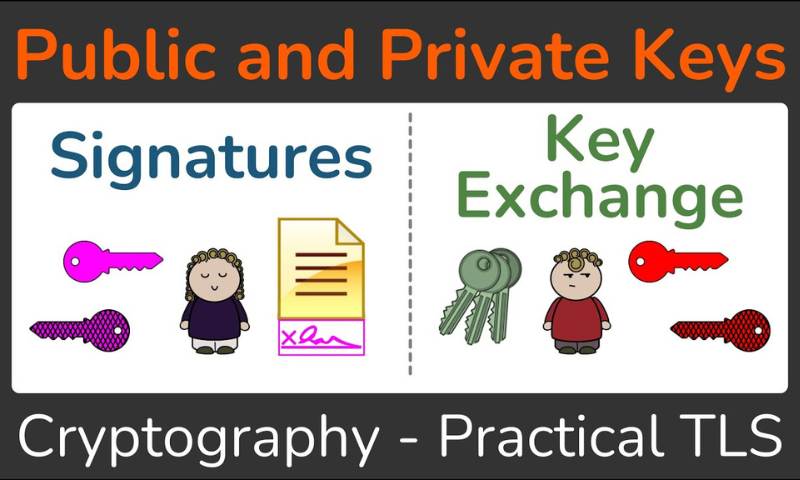How to secure public keys: Your Ultimate Cybersecurity Shield
I get it, cybersecurity can send you spinning. But hang tight, because I’m going to make how to secure public keys a no-sweat task for you. Think of your public keys like the keys to your cyber house. You wouldn’t leave your front door wide open, right? In the digital world, securing these keys is just as crucial. From encryption to the complex dances of asymmetric security, I’ve got the dirt on how to keep your digital fortress safe. Let’s dive into these waters together and lock down your keys with the smarts of a digital locksmith.
Understanding the Basics of Public Key Infrastructure Security
The Role of Public Keys in Encryption
Public keys let you lock your data so others can’t see it. Think of them like a special lock, where you can share the key for this lock with anyone, and they can use it to lock stuff up for you. But only you have the private key to unlock it. This means that you can put your public key out there, and folks can send you info that only you can open up and read. This is how public key encryption keeps your stuff safe from snoopers. It’s a trusty guard for your online privacy.
Fundamentals of Asymmetric Encryption Security
With asymmetric encryption security, there are two keys. Like a pair, one public and one private. They work together so you can exchange info safely. When someone sends you a secret message, they lock it with your public key. But only your private key can unlock it. That’s why protecting your private key is top priority. If someone else gets it, they can read all your locked messages. We call this asymmetric because the two keys are different, not like twins but more like puzzle pieces that fit perfectly.
In public key cryptography, we use complicated math to make these key pairs. It’s these math puzzles that keep our keys safe from hackers. We also have digital signatures to prove who sent a message. They show that the message hasn’t been messed with on its way to you. But if someone messes with the public key, they could trick the system. That’s why safeguarding digital keys is so important.
Public key infrastructure security needs care at every step. We must manage our keys well. This means making new keys before the old ones get too risky to use and keeping track of which keys do what. Encryption key management means having a smart plan for how to use, store, and eventually throw away keys—you can’t just leave them lying around.
When you hear “PKI best practices,” think about all the ways to keep keys safe: secure key storage solutions, making sure nobody messes with the certificate authority trust, and planning for key escrow considerations. All this is just fancy talk for saying “keep your keys under lock and key.”
Every time you use the Internet, this stuff is at work. Whether you’re buying a toy or checking your mail, secure socket layer (SSL) and transport layer security (TLS) are the tech heroes keeping your secrets safe. They use public key encryption to make sure only the right people can read your info. And when we buy stuff, they help check that our card info goes to the store and no one else.
The world of public key cryptography is wide and deep. It touches so much of our daily digital life. From chatting with friends to paying our bills, these keys help keep our digital world turning without letting our secrets spill out. And that’s something worth locking down.
Key Management Protocols and Practices
Designing an Effective Key Rotation Policy
Key rotation is a must for safe keys. It keeps your security tough. We change keys often. This keeps hackers away. By swapping public keys at set times, we make old keys useless to bad guys. Use a clear plan for changing keys.
First, pick a good time frame. It could be months or a year. This time frame depends on how you use your keys. More use means more changes. Make sure to keep logs. Logs help you remember when to switch keys. Tell everybody who needs to know about the new keys. This way, no one gets locked out.
Implementing Key Backup Strategies and Access Control Mechanisms
Next, we talk back up and control. Backups keep keys safe if things go wrong. Like if you lose a key, you can get it back. Use more than one place for backups. This way, you have a plan B. And encrypt your backups. Encrypted backups beat thieves who want to steal keys.
Control who can reach your keys. You don’t want just anyone to grab them. Set rules for who can see or use keys. Use passwords and security questions. Maybe even add a second check, like a code from your phone. This is called two-factor auth. It makes sure you are you.
Now, keys must stay safe when we send them to others. We do this with a key exchange protocol. It’s like a secret handshake. Only the right person gets the key. We keep the bad guys out.
Also, learn the ways of public key infra (PKI). It helps you manage keys and trust. PKI is like a club where everyone knows the rules for keys. It tells you who to trust with keys. It’s all about making sure you and I can talk safe.
Keep your key’s life in mind. From birth to death. This is the key lifecycle. Guard it all the time. If a key goes bad, you have to let others know. This is key revocation. Tell people the key is no good now. Then they stop using it.
Use HSMs to help with keys. They are super safe places for keys. HSMs protect keys from hackers. They’re like vaults for your digital gold.
All these steps are big for safety. They seem small but trust me, they are mighty. Doing them means you stay ahead in the key game. Remember, safety with keys is a race. You want to run faster than the hackers chasing you.
Keep all this in talk as you build your public key defenses. Stay strong and agile. Till next time, keep your keys safe!
Advanced Public Key Protection Techniques
Strategies for Secure Key Storage Solutions
When you’ve got something valuable, you protect it. Think of your public keys the same way. They help keep your data safe. So, how do you guard these keys? By using solid, secure key storage solutions.
First, let’s talk hardware security modules, or HSMs. These are like safes for your keys. Only the right person with the right access can get to them. It’s like a bank vault for your public keys. With an HSM, even if bad guys get into your network, they can’t get to your keys.
Next up, you’ve got key backup strategies. Picture this: you lose your house keys. If you’ve got a spare, you’re in luck! Backing up your keys works the same way. Make copies and keep them safe. This way, if you lose a key, your data isn’t lost for good.
Now, let’s chat about access control mechanisms. You wouldn’t let just anyone into your home, right? Access control is about letting the right people get to your keys. You need a list of who can get in and who can’t. Keep that list tight and up-to-date.
One more thing to think about is the encryption key lifecycle. Your keys need to be born, live their lives, and then say goodbye when the time is right. That means making new keys, using them, and then getting rid of them safely with a good key rotation policy. Don’t use old keys for too long; they get weak over time.
Ensuring Digital Signature Integrity and Certificate Authority Trust
Digital signatures are like your own personal seal. They tell people it’s really you talking or signing something. Protecting these signatures is super important. You need to make sure they’re always right and nobody has messed with them.
Let’s start with digital certificate validity. This is like an ID for your signatures. When your ID is up-to-date, people trust you more. So, keep your certificates fresh and valid. When they expire, people can’t trust your signature anymore.
Then there’s about trusting your certificate authority, or CA. They’re the folks that give out these IDs. You need to choose someone you trust, just like you’d pick a babysitter. If you trust them, you can relax knowing your digital signatures are solid.
Public key cryptography is all about secret messages. With a good key exchange protocol, you can send secrets safely. This is like having a private chat in a crowded room. Only the person you’re chatting with can hear you.
Keep your eyes open for secure communication channels too. Whether you’re texting or emailing, your messages should be locked up tight. So, use SSL and TLS to keep your chats safe. They make sure nobody can sneak a peek at what you’re saying.
So there you have it, friends. Protect your public keys like they’re gold. With the right steps, you’ll keep your data safe and sound. This is how you build your ultimate cybersecurity shield.
Staying Compliant with Modern Security Standards
Leveraging Multifactor Authentication for Key Security
Protecting cryptographic keys is no child’s play. It requires serious skills and smart moves. Think of a digital treasure chest. Your public keys are the gold coins. To keep these gems safe, you need more than a sturdy lock. I’m talking about multifactor authentication (MFA). This is your triple-threat security.
With MFA, we don’t just use a password. We add more checks, like a code from your phone or a scan of your fingerprint. It’s like a high-tech, secret handshake that only you and your chest know. It keeps your keys out of the wrong hands. And it makes sure that even if someone guesses your password, they still can’t get in.
Two-factor authentication (2FA) is a big part of this. It’s like MFA’s little sibling. It uses two ways to check who you are. But MFA adds even more. It’s like adding a whole extra layer of armor to your digital chest.
Now, if you’re using public key encryption, you’re already in a good spot. It turns your sensitive stuff into code that’s super hard to crack. But slap on some MFA, and you’ve got yourself a fortress.
But remember, your fortress is only as strong as its weakest door.
Adherence to PKI Best Practices and Regulatory Requirements
Getting your public key infrastructure security right is a must. It’s like knowing the best way to build a strong fort. And it’s not just about being strong. It’s about following the rules, too.
PKI best practices are like the secret blueprints for that fort. They help you set up your keys, sign them right, and keep tabs on them through their whole lives. It’s key pair protection at its best. With these plans, your keys stay shiny and your locks stay tight.
But, we also need to play by the rules. There are big bosses out there who set these rules to make sure we’re all safe. They cover everything from how you make a key to how long it’s good for. And they’re not just ideas; they’re laws.
Secure key storage solutions are also huge. Think of them as your fort’s hidden vault. You want it out of sight but super tough. Whether it’s in a cloud, on a device, or in a security module, it’s got to be iron-clad. And with hardware security modules (HSMs), it’s like you’ve got an unbreakable safe.
So, let’s keep our public keys in a tight grip. By leveraging MFA and sticking to the rules, we’re making the cyber world a safer place. Our keys are the lifeblood of our digital lives. Let’s guard them like the treasures they are.
We’ve looked at how to keep our online keys safe and sound. First, we learned that public keys are vital for encryption, and that asymmetry is key to secure transfers. We also explored how to change keys safely and back them up, keeping tight control on who can get them.
Then, we dived into top ways to store keys and make sure our digital signs and certificates can be trusted. Finally, we saw how using more than one kind of check—a thing you know plus a thing you have—helps lock it down tight.
Always remember to stick to the rules and best practices. This is how we can trust our online world. My final thought? Good key security is like a strong lock—you need it to keep your digital house safe. Keep it tight, keep it right, and stay safe online.
Q&A :
How can I protect my public keys from being compromised?
Ensuring the security of public keys is crucial since they are used in encryption and necessary for secure communication. To protect public keys, you should always store them in a secure location with proper permissions set, avoiding public servers where they can be easily accessed. Additionally, consider using key management systems that provide layers of security.
What are the best practices for managing public keys safely?
Best practices for managing public keys include using strong cryptographic algorithms, regularly updating and rotating keys, and implementing strict access control measures. Also, it is vital to keep your software up to date with the latest security patches. Using a reputable key management service or a hardware security module can also improve the security of your public keys.
Is it necessary to encrypt public keys?
Public keys by design do not need to be encrypted because they are created to be shared with others to encrypt messages for secure communication. However, the systems that store and distribute these keys should be secure to prevent any tampering or unauthorized distribution.
Can public keys be reused safely?
Public keys can be reused; however, for heightened security, periodically rotating keys is recommended. This practice helps mitigate the risk of a key being compromised over time. Key rotation can be especially important in systems with high-security requirements or those that handle sensitive information.
What are the risks of not securing public keys properly?
Improperly securing public keys can result in various risks, including man-in-the-middle attacks, where an attacker could intercept and decrypt encrypted communication. Additionally, it could lead to unauthorized access, allowing attackers to impersonate legitimate users. Ensuring public keys are properly secured is necessary to maintain the integrity and confidentiality of the communication they protect.


